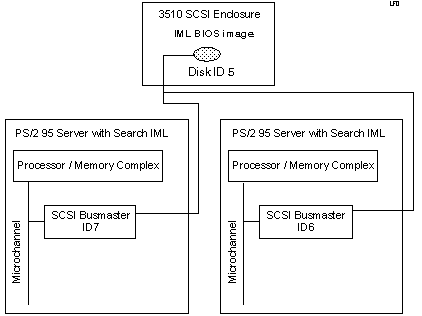Twin Tailing
Twin Tailing
Limits
Twin Tailing and Search IML (Enhanced
BIOS)
Twin Tailing
Twin-Tailing is the term used to refer to attaching one
or more disks to two servers. It has the potential for sharing data and
for increasing availability, but this is only hardware-level support for
twin-tailing, which can be used for read-only files. Software support
would need to be added to ensure that the same file was not being written
to, at the same time, by both systems.
Limitations
(may be dated)
The main limitation of twin-tailing on PS/2s, currently, is
that file sharing has to be controlled either by the application or by
the system design.
- Designate one server as the primary server, and
allow only this server to write to the shared
disks. Both servers can read from
the disks. There is still the risk that data will have been
updated in disk cache on the primary
server and not yet written to the common disks.
- If the disks are accessed only in read mode by
both servers during normal operation, then
there is no risk of corrupt or
out-of-date data.
Twin-Tailing
and Search IML
Search IML also enables twin-tailing to be implemented
with two PS/2 Model 95s and a common IPL disk (held, for example, in a
3510 or 3511 external enclosure). Twin-tailing provides the ability for
a disk to be shared at a hardware level between two systems, and is based
on the ability for two SCSI adapters (in different systems) and one or
more disks to be attached to a common SCSI bus. This is shown in the following
illustration.

Ed. I think I have the correct answer
for the SCSI bus termination.
T --- SCSI /A | -------- 3510 --------- | SCSI /A ---- T
This ignores any SCSI devices past the SCSI adapters. I _assume_
there is no termination between the systems
Search IML supports twin-tailing by enabling the SCSI adapters
to use SCSI IDs 7 and 6, with the external disk being located on, for example,
SCSI ID 5. Search IML will find and load the IML BIOS on this disk from
both systems. Although both adapters support twin-tailing, the 32-bit
IBM SCSI adapters are able to detect that twin-tailing is in operation,
whereas the 16-bit IBM SCSI adapters are not.
9595 Main Page
|
